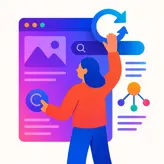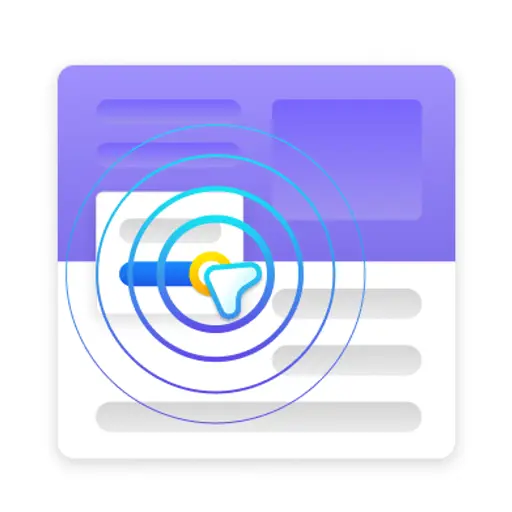Thanks to Rebecca Barnatt-Smith for this week’s article about improving your landing page SEO.
Your landing page is the first thing most customers and prospects see when they come across your website online.
Whether you’re running a one-time promotion or launching an entirely new product range, your landing page is your brand’s chance to make an impression on your target audience.
The question is, how do you make sure your landing page is discovered in the first place? By optimizing your landing page SEO! Keep reading to learn how.
Contents:
- The harsh truth about landing page visibility
- Are landing pages good for SEO?
- Best examples of SEO landing pages
- Can your landing page SEO affect campaign success?
- How to optimize your landing pages for SEO
The Harsh Truth About Landing Page Visibility
As the online search landscape becomes more competitive than ever before, it’s becoming harder and harder to remain visible online.

(Image Source: Ahrefs)
With more than 96% of web pages receiving zero traffic from Google in 2024, it’s crucial that you learn how to optimize a landing page for SEO if you want to drive engagement.
With this in mind, I’ve put together a guide on how to improve your landing page SEO to ensure that it acts as a traffic magnet in your next campaign.
Are Landing Pages Good for SEO?
But first, are your landing pages good for SEO in general? Yes, when optimized, they can be!
Landing pages, otherwise known as squeeze pages, are primarily used to attract and capture leads for conversion. They’re used by both SEO and PPC teams.
While the aim of each landing page is to convert a customer, a well-optimized landing page can also improve your SEO.
Like every web page on the internet, landing pages can be crawled and indexed by Google (unless you block googlebot from doing so). When crawling a web page, search engines look for signs that the page is valuable and relevant to readers.
Considering a number of factors, such as loading speed, time spent on a page, quality of content, and page accessibility, Google’s algorithm decides how authoritative your page appears in comparison to its most similar competitors.
If your landing page SEO isn’t up to scratch, you’re unlikely to rank above your competitors, which will reduce your brand's online visibility.
For example, if a large number of users quickly bounce off your landing page due to slow loading times or irrelevant content, this repeated action tells Google that your page is unhelpful, resulting in a lower SERP ranking.
On the other hand, if your landing page is full of engaging content and has an effective call to action, this tells Google that your brand is a trusted source, resulting in a higher SERP ranking.
The SERP position of your landing page affects the ranking of your entire domain, so it’s crucial that you’re on the right side of the ranking algorithm.
What to Include in a Landing Page
An SEO-friendly landing page should include:
- A focus on targeted keywords and searchable phrases
- Interactive call-to-action button(s)
- Useful links within the HTML
- Accessible navigation for users on all devices
- High-quality, authoritative, helpful content
- Fast loading speeds and constant uptime
When optimized, a landing page can act as a traffic magnet for your target leads, as well as an asset to your SEO strategy.
The Best SEO Landing Pages To Take Inspiration From
Let’s take a look at some of what I think are the best SEO landing page examples to get some inspiration.
With brilliant use of competitive keywords and stand out calls-to-action, here are a few brands currently ranking highly with their landing pages.
Drift
First up, let’s talk about Drift. Their introductory guide page to conversational marketing continues to rank at the top of the pack for the topic, which is not surprising.

(Image Source: Drift)
They make extensive use of relevant searchable keywords, such as ‘conversational marketing’ and ‘conversational marketing software,’ which quickly attracts relevant leads and increases the chances of visitors staying on their page for longer.
Better still, the landing page itself is full of top-notch graphics and well-optimized visuals that are both interactive and engaging for its audience.
Drift’s landing page is long-form and informative, containing content that caters to multiple variations on the topic, as well as links to supporting content (see below).

CopyAI
Another great example comes from CopyAI. This SEO-friendly landing page features well-optimized titles, meta tags and attention-grabbing calls-to-action.

(Image Source: CopyAI)
CopyAI’s landing page for their Instagram Caption Generator hooks you the minute you see the word ‘free.’ This is then followed up with some great CTA tactics, such as the highlighting of the ‘Try Free Today’ button and the simplicity of a minimalist yet bold design.
ActiveCampaign
ActiveCampaign is also a brilliant example of a brand that knows how to create a traffic-generating landing page.

(Image Source: ActiveCampaign)
This brand has used its good performance on G2 to its advantage when crafting a subscription page. On first impression, the page has a simplistic UX design, but there are a number of award badges for social proof, and a quick call to action.
Taking a minimalist approach to landing page design, ActiveCampaign makes it easier for search engines to crawl and index its page by keeping visual content to a minimum. This makes it quicker to load, reducing bounce rate as a result.

As you scroll further down, ActiveCampaign actively shows each visitor how their service works in a set of interactive infographics. This helps to increase time on page, letting search engines know that the content is helpful and engaging.
Can Your Landing Page SEO Affect The Success of Your Next Campaign?
While most marketing campaigns are short or seasonal, many marketers neglect the SEO of new landing pages.
This is why the average bounce rate for a new landing page is between 60-90%.
If you want to drive more traffic to your newest campaign, optimizing your landing page could help improve your campaign’s visibility and improve that bounce rate.
Optimizing your landing page SEO can:
- Improve your page loading time: This makes it easier for site visitors to interact with your content.
- Make it easier for search engines to crawl your page: This can lead to quicker indexing.
- Increase visibility: If you optimize your landing page for relevant searchable keywords, your audience will be more likely to find your campaign.
If you plan to run a repeat campaign, such as a seasonal set of products that come out once or twice a year, landing page SEO is especially important.
Why is that, you ask? Well, each time you create a new landing page, you’re essentially starting from scratch when it comes to ranking in the SERPs, which means you could be missing out on lots of convertible traffic.
If you create and optimize an SEO landing page for a seasonal campaign that can be used again for future promotion, you’re already one step ahead of the search engines and two steps ahead of the 48% of marketers who create a brand new landing page for each campaign.
Take the tech retailer Currys, for example. After switching up its landing page SEO strategy in 2014, the brand has since kept its ‘Black Friday’ landing page online all year round. While the landing page is largely inactive throughout the rest of the year, you’ll see that the keywords ‘Black Friday’ remain in the URL and are dotted around the page numerous times.

(Image Source: Currys)
This means that when it comes to November each year, all the SEO authority the brand has built up previously is still there, waiting to be built on.
How To Optimize Your Landing Page For SEO
With the benefits of a strong landing page SEO strategy in mind, this is how to pull it off.
Before you start, it’s worth conducting a technical SEO audit or website performance audit to highlight any issues and areas of improvement. This provides you with a brilliant starting place to begin work on your newest landing page.
Now, these are five strategies I come back to whenever optimizing a landing page for SEO.
1. Strategically Place Your Target Keywords
It’s no secret that keywords drive a strong SEO strategy, so it’s important to use your keywords strategically on your landing page if you want to see success.
Once you’ve established your target phrases, make sure they’re included in key areas that will be picked up by a search engine crawler, for example image ALT tags, headings and the meta description.
Editor’s Note: It’s worth checking that critical content is not reliant on JavaScript in order to become immediately visible and indexable by search engines. If you’re not sure how to do this, check out the our free JavaScript SEO resources.
2. Prioritize Mobile Friendliness
Did you know that over 53% of visits are abandoned if a mobile site takes longer than 3 seconds to load?
As more people reach for their smartphones to search for content online, landing pages that are not accessible via a mobile screen will quickly fall to the bottom of the ranking pile.

(Image Source: Google)
Mobile friendliness is a crucial ranking factor in 2024. In order to achieve this, ensure that you follow Google’s guidelines for mobile optimization.

(Image Source: Google)
3. Include Schema Markup
Landing pages with schema markup are helpful to search engines.
Schema markup is structured data code added to a webpage to help search engines understand the page content. You can do this manually, or coding beginners can use a schema markup generator.
With an improved understanding, search engines are more likely to rank your content higher for relevant search queries, leading to high click-through rates and more traffic on site.
4. Craft High-Quality Content
Your landing page content should include your campaign's key selling points, quick calls-to-action, and a direct path to conversion.
If your landing page is centered around a longer-form piece of content like a blog post or press release, ensure that your writing is easily readable and contains relevant keywords and phrases.
If you want your written content to rank well, it’s also important to avoid AI-generated writing tools like ChatGPT, as search engines are smarter than ever at detecting AI writing.
In addition to your writing efforts, remember to include engaging multimedia elements, such as images, videos, charts, and infographics.
After 72% of consumers claimed that they prefer to engage with video content online, adding visuals to your landing page could attract more consumers to your content, in turn raising your time-on-page score.
5. Maximize Your Backlinking Efforts
A landing page is no different to any other page of your website. If a referring domain links to your landing page, Google deems this as a vote of confidence, which can help it to rank higher in the SERPs.
Generating backlinks for your landing page is therefore important if you want it to gain visibility online.
To do this, make sure that your landing page is extremely sharable. Publish stats within your content that can be shared across the web, as well as original infographics that can be sourced back to your website. Why not also encourage consumers to share your campaign content on social media, linking back to your landing page within their feed?
The more links you can generate, the more signals you send to search engines that you’re a leading voice within your industry.
Wrapping Up
Landing page SEO is just as important as other forms of SEO. Those who nurture their landing page SEO can improve their chances of driving more traffic to campaigns and converting new customers.
Your landing page is often your brand’s first impression on a potential consumer. So make it count.
You might also like:

Rebecca is a freelance journalist and a content manager at Solvid Digital. She specialises in all things SEO and likes to write about the newest digital marketing trends on the block.
Articles for every stage in your SEO journey. Jump on board.
Related Articles
 How to Stay Relevant in a World of AI Overviews & Query-Fans
How to Stay Relevant in a World of AI Overviews & Query-Fans
 Content Refresh Guide: How to Improve Your Search & AI Visibility
Content Refresh Guide: How to Improve Your Search & AI Visibility
 How to Optimise Agent Relationships & Content for Better Real Estate Marketplace SEO
How to Optimise Agent Relationships & Content for Better Real Estate Marketplace SEO
 Sitebulb Desktop
Sitebulb Desktop
Find, fix and communicate technical issues with easy visuals, in-depth insights, & prioritized recommendations across 300+ SEO issues.
- Ideal for SEO professionals, consultants & marketing agencies.
Try our fully featured 14 day trial. No credit card required.
Try Sitebulb for free Sitebulb Cloud
Sitebulb Cloud
Get all the capability of Sitebulb Desktop, accessible via your web browser. Crawl at scale without project, crawl credit, or machine limits.
- Perfect for collaboration, remote teams & extreme scale.
If you’re using another cloud crawler, you will definitely save money with Sitebulb.
Explore Sitebulb Cloud
 Rebecca Barnatt-Smith
Rebecca Barnatt-Smith



